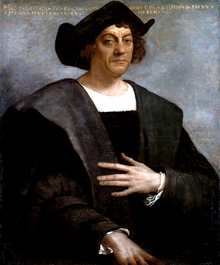| Christopher Columbus | |
|---|---|
 Posthumous portrait of Christopher Columbus by Sebastiano del Piombo. There are no known authentic portraits of Columbus.[1] | |
| Born | Between 22 August and 31 October 1451 Genoa, Republic of Genoa, in present-day Italy |
| Died | 20 May 1506 (aged 54) Valladolid, Crown of Castile, in present-day Spain |
| Nationality | Genoese |
| Other names | Italian: Cristoforo Colombo Catalan: Cristòfor Colom Spanish: Cristóbal Colón Portuguese: Cristóvão Colombo Latin: Christophorus Columbus Genoese: Christoffa Corombo |
| Occupation | Maritime explorer for the Crown of Castile |
| Title | Admiral of the Ocean Sea; Viceroy and Governor of the Indies |
| Religion | Roman Catholic |
| Spouse | Filipa Moniz Perestrelo (c. 1455–85) |
| Partner | Beatriz Enríquez de Arana (c. 1485–1506) |
| Children | Diego Fernando |
| Relatives | Giovanni Pellegrino, Giacomo and Bartholomew Columbus (brothers) |
| Signature |  |
In the context of emerging western imperialism and economic competition between European kingdoms seeking wealth through the establishment of trade routes and colonies, Columbus' far-fetched proposal to reach the East Indies by sailing westward received the support of the Spanish crown, which saw in it a promise, however remote, of gaining the upper hand over rival powers in the contest for the lucrative spice trade with Asia. During his first voyage in 1492, instead of reaching Japan as he had intended, Columbus landed in the Bahamas archipelago, at a locale he named San Salvador. Over the course of three more voyages, Columbus visited the Greater and Lesser Antilles, as well as the Caribbean coast of Colombia, Venezuela and Central America, claiming them for the Spanish Empire.
Though Columbus was not the first European explorer to reach the Americas (having been preceded by the Norse expedition led by Leif Ericson[6]), Columbus' voyages led to the first lasting European contact with America, inaugurating a period of European exploration and colonization of foreign lands that lasted for several centuries. They had, therefore, an enormous impact in the historical development of the modern Western world. Columbus himself saw his accomplishments primarily in the light of the spreading of the Christian religion.[2]
Never admitting that he had reached a continent previously unknown to Europeans, rather than the East Indies he had set out for, Columbus called the inhabitants of the lands he visited indios (Spanish for "Indians").[7][8][9] Columbus' strained relationship with the Spanish crown and its appointed colonial administrators in America led to his arrest and dismissal as governor of the settlements in Hispaniola in 1500, and later to protracted litigation over the benefits which Columbus and his heirs claimed were owed to them by the
crown.

Tidak ada komentar:
Posting Komentar